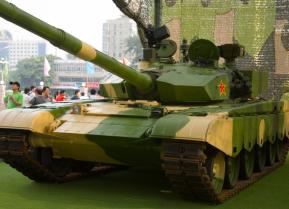China's Type 15 Tank: Ready to Fight India In a War?
China’s type 15 light tank, Beijing's smallest tank, might be its best answer to cold, high-altitude mountain warfare. Here's why.
China’s type 15 light tank, Beijing's smallest tank, might be its best answer to cold, high-altitude mountain warfare. Here's why.
The India Challenge
It’s a fact that tanks are by nature, big heavy beasts. Take for example the M1 Abrams, the United States’ main battle tank. Since its introduction into American service in the early 1980s, the venerable Abrams has ballooned in size to the point where it maybe is too heavy to quickly get to the front lines.
It is clear that the trend in main battle tank design is bigger and heavier — perhaps too heavy. Partially in recognition of the M1 Abrams’ high curb weight, the United States Marine Corps has deactivated all their tank battalions, part of their strategy for pivoting from long grinding land battles in the Middle East toward dynamic maritime warfare the Corps anticipates in the Western Pacific in the future.
And it is not just the Marines who are concerned with increasingly heavy tanks. Beijing is also aware of the danger of excessive tank weight, though for a slightly different reason.
China’s Armor
Like the M1 Abrams, China’s Type 99 and Type 96 main battle tanks are heavy, though they don’t tip the scales quite as much as their American counterpart. Still, their combat effectiveness could suffer in conditions where nimbleness — made possible by lower weight and therefore lower ground pressure — would be needed. Think high-altitude mountain environments.
In these types of environments, the smaller Type 15 tank would fill in for China's Type 99 and Type 96 tanks. The Type 15 is by comparison, diminutive. Weighing in at around 35 tons, it is half the weight of the Abrams. Unlike its larger brethren, the Type 15 has a smaller 105mm main gun, though it retains the robust armor package and CBRN protection that larger tanks have. It also greatly benefits from a high power to weight ratio, afforded by a 1,000 horsepower diesel engine.
Last summer, the South China Morning Post reported that Type 15 tanks had been sent to the Tibetan Plateau near a disputed border area claimed by both China and India. The Type 15’s arrival was seen by some military analysts as muscle-flexing on the part of the Chinese, as that particular tank would be more likely to excel in a mountainous environment.
Not only that, but they’re being further optimized for a high-altitude fight.
Jane’s reports that at least some of China’s Type 15 tanks have been outfitted with so-called “plateau” engines, likely optimized for cold, oxygen-poor environments. In addition, Type 15’s have been supplied with “oxygen-production equipment” probably to ease breaking for tank crews, and possibly to ensure enough oxygen is supplied to the tank’s engine to support reliability.
Postscript
Like much of China’s military, the Type 15 has not been tested in combat. Experience aside, Beijing seems to be planning ahead and preparing for a dustup on the Tibetan Plateau.
Caleb Larson is a Defense Writer based in Europe. He holds a Master of Public Policy and covers U.S. and Russian security, European defense issues, and German politics and culture.


